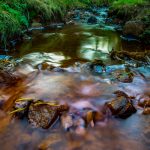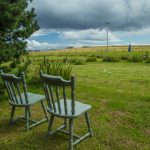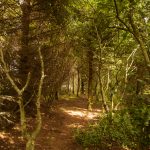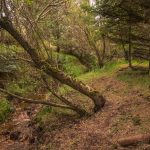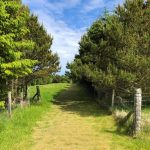Whilst you are staying at Pabbay House please feel very welcome to use our croft. The croft is situated opposite the house and enter through the trees to the left, behind the car park.
A croft is a narrow strip of ground for agricultural purpose. In effect it is a very small farm.
Please use the seats and benches, to simply sit and enjoy the sound of silence or the call of a bird. Why not take a cup of tea or hot chocolate with you to enjoy a peaceful moment.
We also have a short “forest walk” for our guests to enjoy. Please follow the white marker posts to complete a short loop. The walk follows the course of the iron rich water of the “Back Burn”.
Our intention is to continue to plant native tree species to create a rich diverse habitat which can be enjoyed by both humans and birds. The shelter provided will also benefit livestock.
The croft can also be used to access the wonderful Back beaches we are privileged to have on our doorstep. To get to the sea and beaches simply follow the croft all the way down. The path comes out behind our own house but please do not feel inhibited to walk past our house. Simply cross the main road to get to the sea and also the Gress River half way along the beach.
The croft is there for your enjoyment, please use it.
Tent- If you and your children would like the experience of camping, here in Lewis, to enjoy the great outdoors, we can supply a tent and sleeping bags. The tent will be erected on our croft opposite Pabbay House.
We would advise that a parent should be present with their children, in the tent, at all times.
Please ask about using the tent if you are interested.
We are not a campsite. This facility is simply for families, staying at Pabbay house, to enjoy, should the weather be agreeable.
Our woodland at Pabbay House is constantly evolving. At the moment it is quite exciting. The trees are beginning to naturally regenerate and we have our own seed source!
The woodland provides excellent shelter for livestock and each year we see and hear new species of birds in the trees. Local wood crafts people are using the timber for their products.
Our aim is to recreate a tiny part of the “Celtic rain Forest “, right here on Lewis. This forest once stretched right up the West coast of Britain including the Celtic countries of Ireland, Wales and Scotland. The Celtic Rain-forests of Scotland, also known as Atlantic woodlands, form part of the wider western Atlantic woodlands of the UK. They are a habitat known as ‘temperate rain-forest’. Temperate rain-forest is a rare habitat worldwide - rarer even than tropical rain-forests! These mainly coastal forests have a special 'oceanic' climate, which is very wet and mild, due to landscape and warm ocean currents.
The combination of high rainfall and stable mild temperature makes the woodlands very humid which allows for the growth of some really special residents – the lichen, mosses and liverworts, fungi and ferns. It is these species that really make the Celtic Rain-forests what they are. Not only do they help maintain the humidity in the forest but they also give the forests that mysterious and magical feel.
As part of this we hope to highlight within the wood the “Trees of the Celtic Alphabet”. This old alphabet was known as Ogham. This is essentially a twenty-letter alphabet apparently developed for “Primitive Irish”, the ancestor to the better-known Old Irish, which is effectively the ancestor of all three contemporary Gaelic languages (Irish, Manx, and Scottish Gaelic). Ogham does not have single characters to signify individual letters. Instead each letter has been given a certain number of single strokes placed along a vertical line. The Celts actually associated a tree for each letter of the Ogham. For example C is represented by Coll in Gaelic which translates as Hazel in English.
Beith, corresponds to the letter B in the alphabet, and is associated with the Birch tree. When this symbol is used, it is representative of new beginnings, change, release, and rebirth.
Birch trees are hardy. They'll grow just about anywhere, including on bare soil. Because they tend to grow in clusters, what may be just one or two seedlings now can be practically an entire forest in a few decades. In addition to being a sturdy sort of tree, the Birch is useful. In days gone by, it was used for infants' cradles, and is still harvested today to make cabinets and furniture. Ancient herbalists discovered that various parts of this tree have medicinal uses. Bark was once brewed into a tea to fight fevers, and the leaves were used alternately as a laxative and a diuretic, depending on how they were prepared.
These trees gradually entered into the folk lore and tradition of the Celts.
So we hope to create a woodland walk ‘through the Gaelic Alphabet’ where our guests can rest, enjoy and understand how the characteristics of the various trees reflect back the diversity of the natural world.

